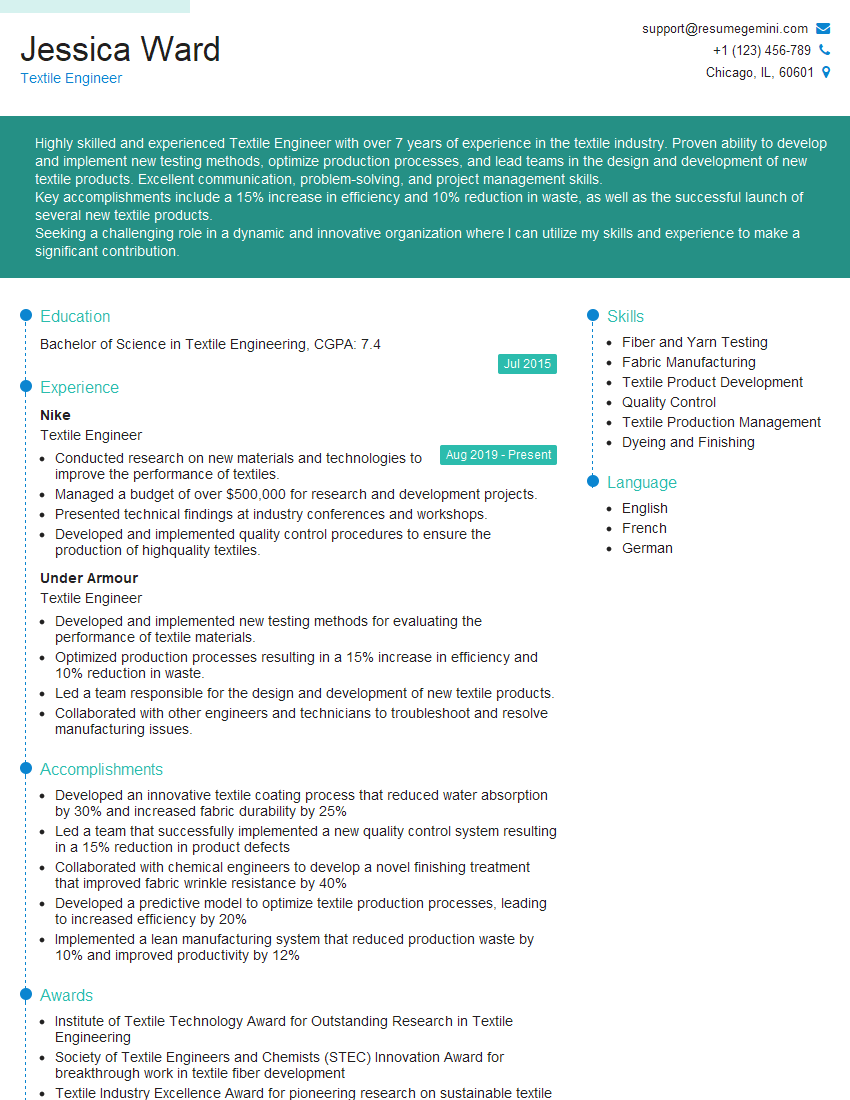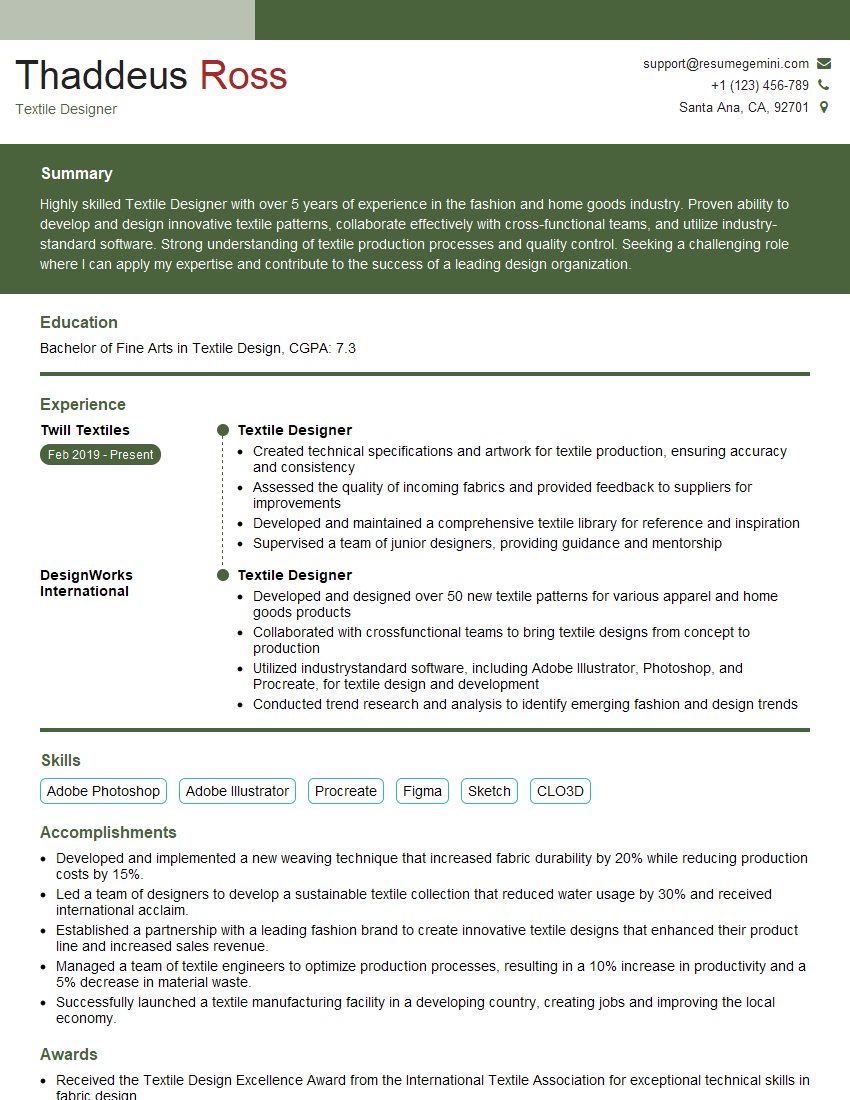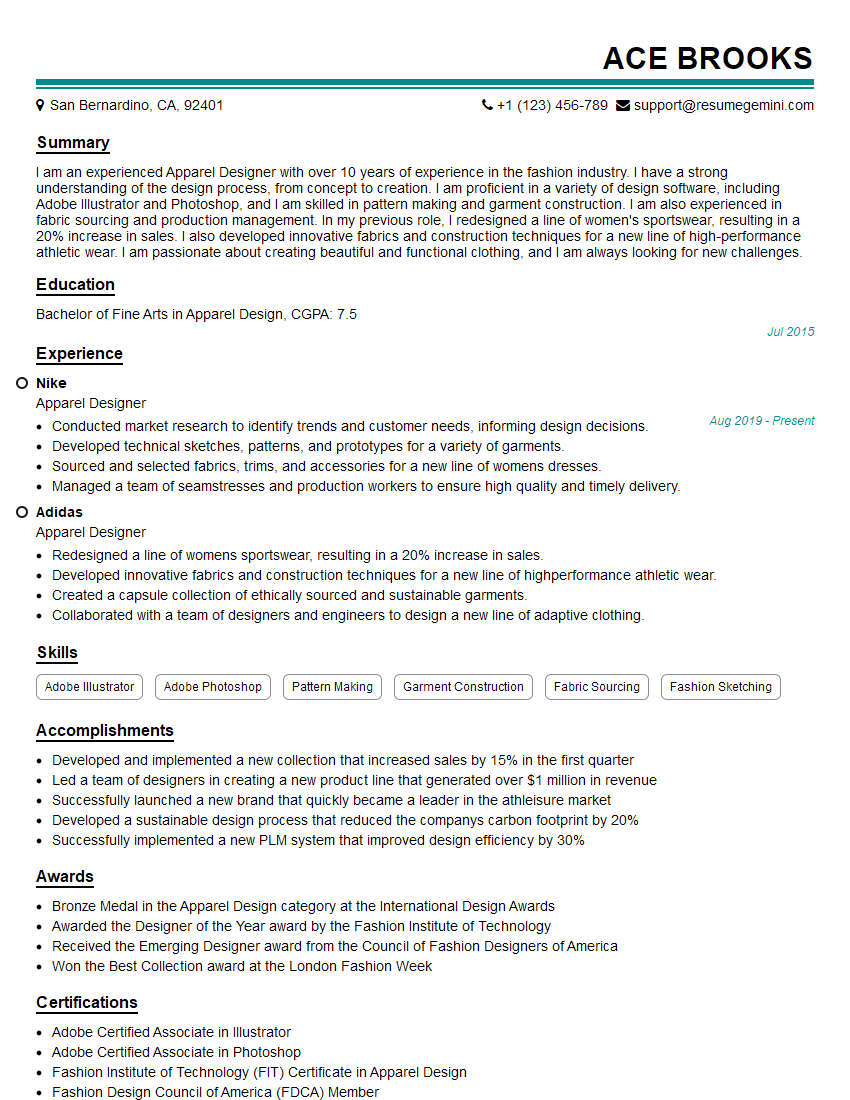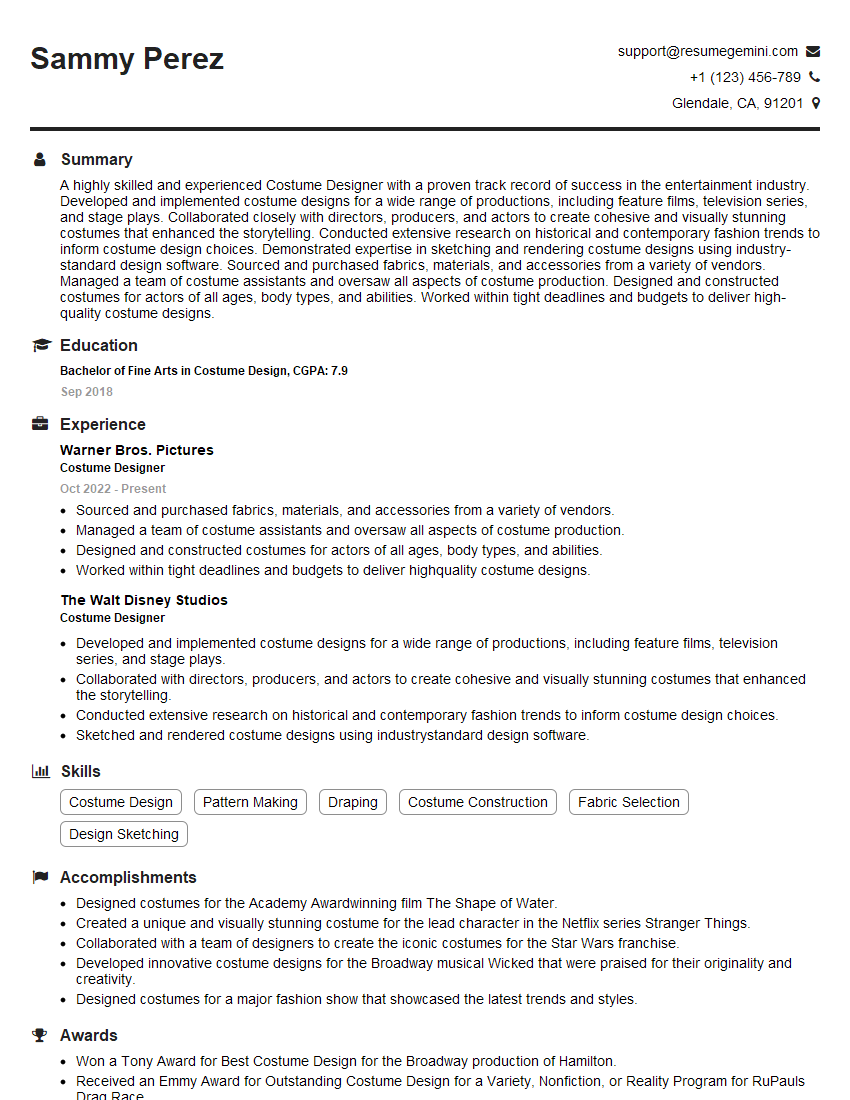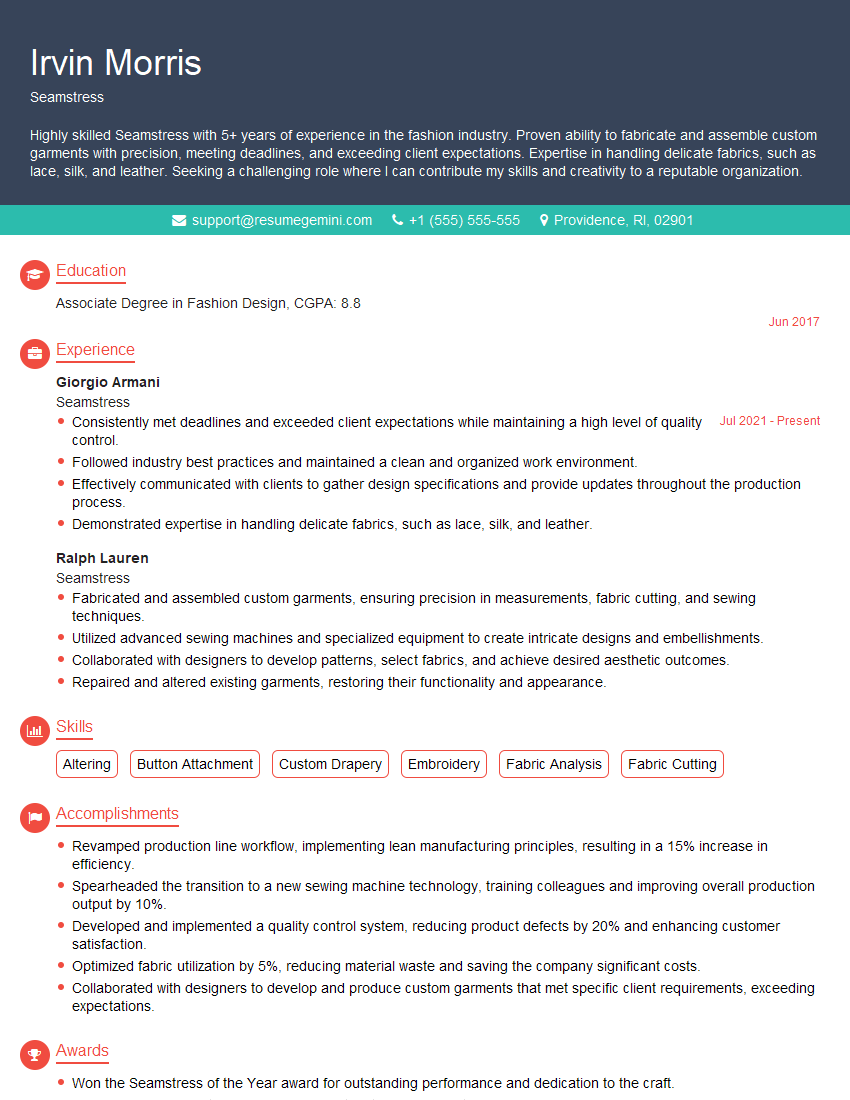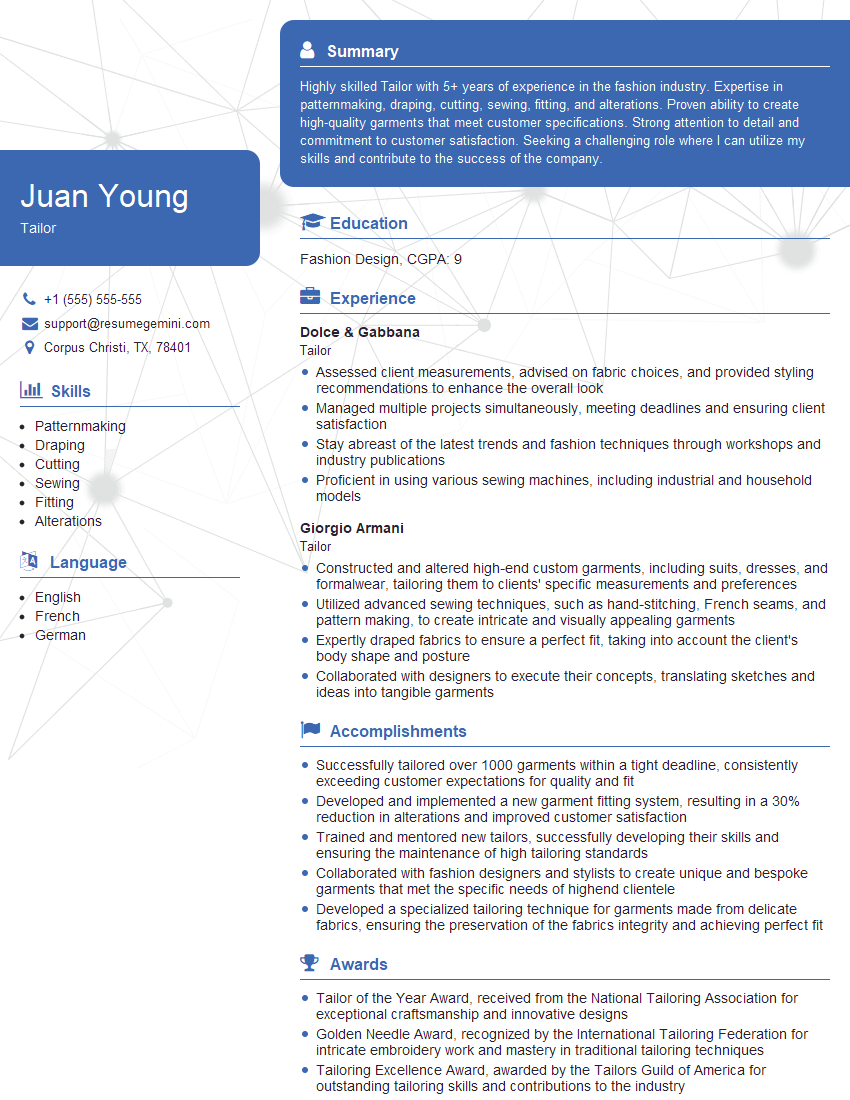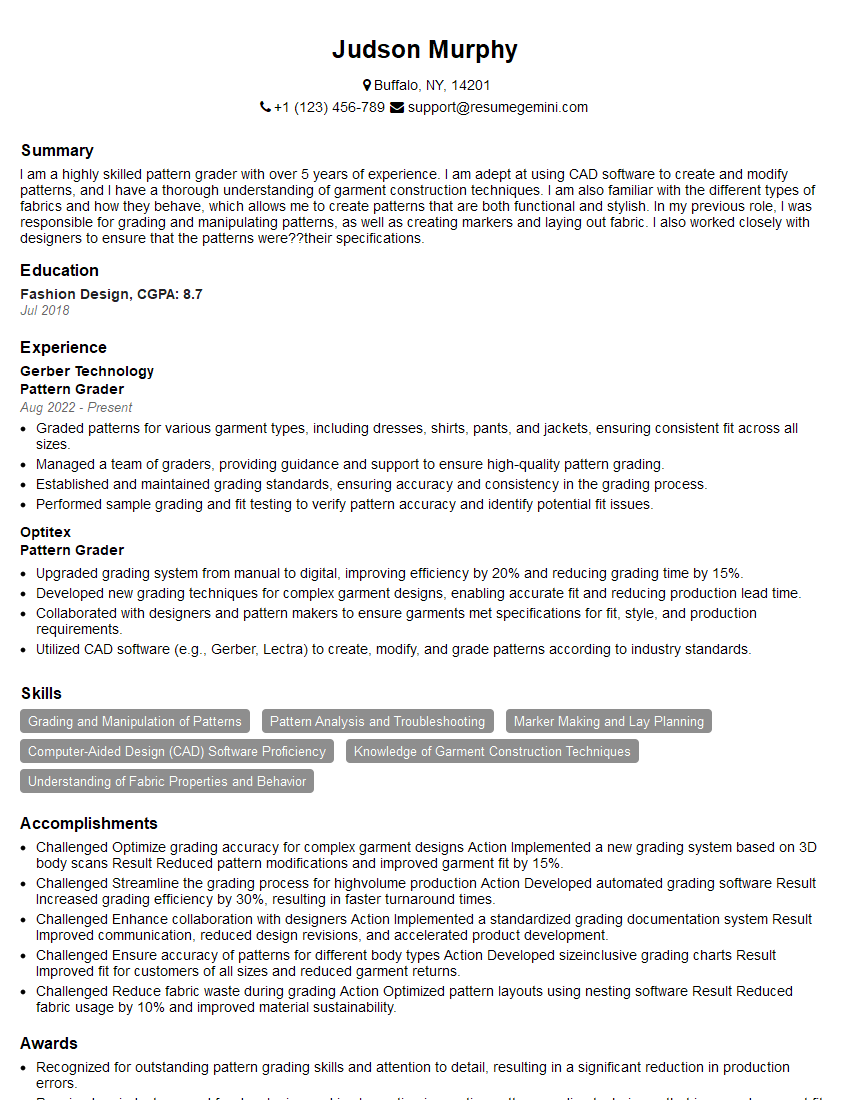Cracking a skill-specific interview, like one for Pleating and Gathering Techniques, requires understanding the nuances of the role. In this blog, we present the questions you’re most likely to encounter, along with insights into how to answer them effectively. Let’s ensure you’re ready to make a strong impression.
Questions Asked in Pleating and Gathering Techniques Interview
Q 1. Explain the difference between knife pleats and box pleats.
Knife pleats and box pleats are both types of pressed pleats, creating sharp folds in fabric, but they differ in their construction. Knife pleats are single folds pressed in one direction, creating a series of parallel pleats. Think of them like a row of knives laid flat. Box pleats, on the other hand, involve two knife pleats folded together, creating a wider, more substantial pleat with a distinct ‘box’ shape. Imagine two knife pleats meeting in the middle to form a square.
Knife Pleats: These are simpler to create and are often used in skirts, dresses, and blouses where a flowing, less structured look is desired.
Box Pleats: These are more complex, requiring precise folding and pressing, and are frequently used for more formal garments or where a structured, sharply defined pleat is needed, like in a tailored skirt or pleated trousers.
Q 2. Describe the process of creating a sunburst pleat.
Creating a sunburst pleat involves pleating fabric radially from a central point, resembling the rays of a sun. It’s a beautiful and dramatic technique often used for skirts, tops, or even decorative elements.
The process begins by determining the center point. From this point, you’ll measure and mark radiating lines, creating equal segments. Each segment then gets pleated individually, usually using a knife pleat or similar technique. The pleats are pressed flat, and then the entire piece is carefully stitched together, ensuring the pleats radiate smoothly from the center. Precision and careful planning are key to achieving a flawless sunburst pleat. Using a pattern or template is highly recommended, especially for larger or more complex designs.
Q 3. How would you achieve even pleat spacing in a large garment panel?
Achieving even pleat spacing on a large panel requires careful planning and execution. One effective method is to use a pleating board or template with pre-marked spacing lines. You can create this template easily using cardboard or even a stiff fabric piece. Another method involves using a ruler and tailor’s chalk to mark the pleat positions directly onto the fabric. For precise spacing, calculate the total width of the finished pleats and divide that by the number of pleats you want to create to determine the width of each pleat section. Remember to account for the width of the fabric compressed by the pleats themselves. This ensures consistent spacing across the entire panel. Once marked, you fold along these lines, ensuring each pleat is uniform before pressing.
Q 4. What fabrics are best suited for pleating, and why?
Not all fabrics pleat equally well. The ideal fabric for pleating possesses body, drape, and memory. This means the fabric needs to hold its shape well after being pleated and resist wrinkling or sagging.
- Crisp fabrics like cotton lawn, linen, and silk organza hold their pleats beautifully because of their inherent stiffness and structure. They are easy to press and maintain the desired shape.
- Medium-weight fabrics like wool crepe and gabardine also work well, though they might require more careful pressing to avoid unwanted creases.
- Lightweight fabrics like chiffon or georgette can be pleated, but they often require special techniques (such as using a fusible interfacing) to help them hold their shape.
Avoid excessively stretchy or flimsy fabrics as they’ll likely lose their pleats quickly.
Q 5. What are the common challenges encountered when pleating delicate fabrics?
Delicate fabrics, like silk charmeuse or fine lace, present unique challenges when pleating. Their fragility makes them prone to snagging, tearing, or stretching.
- Needle marks: Fine needles are crucial to minimize holes.
- Fabric stretching: Gentle handling and careful measuring are crucial to prevent distortion.
- Maintaining Shape: Using appropriate interfacing or lightweight support materials to maintain shape and prevent sagging.
- Pressing issues: Low heat settings and pressing cloths are essential to avoid scorching or damage.
Practice on a scrap piece of the fabric before attempting the final garment to perfect your technique and prevent potential damage.
Q 6. How do you prevent pleats from unraveling or shifting during garment construction?
Preventing pleats from unraveling or shifting during construction requires careful preparation and stitching.
- Secure stitching: Use small, close stitches to hold the pleats firmly in place. Consider using a sewing machine with a smaller stitch length for precise control.
- Pressing: Thorough pressing after each step helps to set the pleats and reinforces the shape. Use a press cloth for delicate fabrics.
- Stay stitching: Adding a stay stitch along the fold lines before pleating can provide extra stability.
- Interfacing: For delicate fabrics, a lightweight fusible interfacing can prevent distortion during garment construction and add structure to the pleats.
- Under stitching: After pleating, the under stitching reinforces the pleats from the inside, which is especially helpful in preventing shifting and unraveling in the finished garment.
Q 7. Explain the different methods for gathering fabric.
Gathering is a technique to condense fabric, creating fullness. Several methods exist, each with its own advantages:
- Machine Gathering: This is the most common method. Use a long basting stitch (typically a very loose zig zag) along the raw edge. Gently pull the bobbin thread to gather the fabric to the desired length. Adjust the stitch length for finer control.
- Hand Gathering: This offers more precise control, especially for delicate fabrics or intricate designs. Gather the fabric using running stitches along the raw edge, pulling the thread gently to create gathers. It’s more time-consuming, but gives precise gathers.
- Shirring: Shirring is a type of gathering that uses rows of closely spaced stitching to create even, fine gathers. This method creates a more structured and even gathering effect. Typically uses sewing machine with elastic thread on the bobbin.
The chosen method depends on the fabric, desired fullness, and your time constraints.
Q 8. Compare and contrast shirring and smocking techniques.
Shirring and smocking are both decorative fabric-gathering techniques, but they differ significantly in their methods and resulting appearance. Shirring uses elastic thread to create a series of evenly spaced gathers, resulting in a soft, flexible, and often bouncy texture. Think of the comfortable gathers on a casual dress or a drawstring bag. Smocking, on the other hand, involves intricate hand or machine embroidery stitches that create shaped gathers, often forming a patterned surface. This technique produces a much more structured and formal look, often seen in heirloom garments or elegant blouses. Essentially, shirring is a quick and functional method for gathering, while smocking is a time-consuming, highly decorative art form.
- Shirring: Uses elastic thread, creates even gathers, relatively quick and easy.
- Smocking: Uses embroidery stitches to form gathers, creates structured and patterned gathers, time-consuming and requires skill.
Q 9. How do you calculate the correct amount of fabric needed for gathering?
Calculating the correct fabric amount for gathering depends on the desired fullness. A general rule of thumb is to add 1.5 to 2 times the finished measurement. For example, if you need a 12-inch gathered section, you’ll need 18 to 24 inches of fabric. However, this is a starting point, and the exact amount will vary depending on the fabric’s drape and the gathering technique used. Heavier fabrics require less added length, while lighter, more drapey fabrics will require more.
To be more precise, I often create a sample gather. I’ll cut a small piece of the fabric, baste it, and gather it to see how much fullness I achieve with a given amount of added fabric. I can then adjust my calculations based on the sample. This method is especially useful with unique or unfamiliar fabrics.
Q 10. What techniques can be used to control the fullness of gathered fabric?
Controlling the fullness of gathered fabric is crucial for a polished finish. Here are several techniques:
- Adjusting the tension of the gathering stitches: Looser stitches create more fullness, tighter stitches less. This is a fundamental control point.
- Using different types of thread: Using a heavier thread can create more defined gathers. Conversely, finer thread will create softer, less defined gathers. Experimentation is key.
- Varying the spacing of the gathering stitches: Closely spaced stitches produce more fullness, while wider spacing yields less.
- Pre-shrinking the fabric: This is critical, especially with natural fabrics like cotton or linen, to prevent uneven shrinking after the project is completed.
- Using gathering tools: Specialty gathering tools like ruffler feet for sewing machines offer more precise control over the fullness, speed, and consistency of the gathers.
These techniques can be combined to achieve very precise control. For instance, using tightly spaced basting stitches with a heavy thread followed by adjustment with a less-full gather stitch offers a way to control excess fullness easily.
Q 11. How does fabric weight influence your choice of pleating or gathering technique?
Fabric weight significantly impacts the choice between pleating and gathering. Heavy fabrics like wool or brocade tend to hold pleats better than gathers. The structure of the pleat allows it to retain its shape and provides a crisp, clean look. Attempting to gather heavy fabrics can result in uneven fullness or stress on the seams. In contrast, lightweight fabrics like chiffon or silk often lend themselves more readily to gathering. The drape of the fabric contributes to the beautiful, fluid movement that gathering produces. Pleating a lightweight fabric can result in it losing its crisp structure.
Essentially, pleating is best suited for stiffer fabrics needing structured shaping and gathers for softer, more flowing materials.
Q 12. Describe a time you had to troubleshoot a pleating or gathering issue.
I once worked on a custom wedding dress featuring intricate knife pleats on the bodice. The fabric, a delicate silk organza, was proving extremely difficult to pleat evenly. The pleats kept slipping, and the process was incredibly time-consuming and frustrating. My initial approach involved using a fine-gauge needle and basting the pleats in place with a very fine thread. However, this method still resulted in unevenness. After analyzing the problem, I realized that the silk organza was simply too slippery. The solution involved applying a very lightweight fusible interfacing to the reverse side of the fabric before pleating. This provided the necessary grip to hold the pleats in place throughout the process. The final result was a perfectly tailored bodice, and it taught me the importance of understanding the unique challenges presented by different fabrics and finding creative solutions.
Q 13. What are some innovative pleating or gathering techniques you are familiar with?
Beyond traditional techniques, I’m fascinated by innovative methods like:
- Laser cutting for pleating: This technology allows for intricate and highly precise pleating patterns that would be impossible to achieve manually. It offers speed and incredible detail, opening up new possibilities in design.
- 3D-printed pleats: While still evolving, 3D printing opens doors to create complex, sculptural pleats and gathers that defy traditional methods. This is currently being explored for fashion and other fields.
- Heat-bonding techniques: Using heat and pressure to create pleats in certain fabrics eliminates the need for stitching in some cases, creating sharper, more permanent pleats.
These methods combine technology with textile arts to expand the creative potential of pleating and gathering techniques.
Q 14. Explain the role of interfacing in pleating and gathering.
Interfacing plays a crucial role in pleating and gathering, particularly when working with delicate or unstable fabrics. It provides support and stability, preventing the fabric from stretching or distorting during the process and ensuring the pleats or gathers hold their shape over time. For pleating, a lightweight fusible interfacing can be applied to the wrong side of the fabric, helping maintain crispness and prevent the pleats from sagging or losing their definition. For gathering, a soft interfacing can provide body and structure to the fabric, particularly when dealing with thin or sheer materials, making the gathering process smoother and resulting in even, beautiful gathers. The type of interfacing selected will greatly depend on both the base fabric and the final desired look. A heavier interfacing might be used for a bolder look while a sheer interfacing allows for more subtle definition.
Q 15. How would you handle uneven pleats or gathers in a finished garment?
Uneven pleats or gathers in a finished garment are frustrating, but usually fixable! The key is to identify the cause of the unevenness before attempting a repair. Often, it stems from inconsistent stitch length, inaccurate marking, or uneven fabric distribution during the pleating/gathering process.
Identifying the Problem: Carefully examine the garment. Are the pleats unevenly spaced? Are some pleats deeper than others? Is the fabric bunching in certain areas? This helps pinpoint the source of the issue.
Solutions:
Minor Adjustments: For slight imperfections, carefully steam the area to relax the fabric. You can then gently reposition the pleats or gathers by hand, using pins to secure them in place before re-stitching.
Major Corrections: If the unevenness is significant, you may need to carefully unpick the stitching, re-mark the pleats/gathers accurately, and re-stitch. This requires patience and attention to detail.
Prevention: The best approach is to prevent unevenness from the start. Use a good quality fabric, carefully mark your pleats/gathers, maintain consistent stitch length, and use appropriate interfacing if necessary. Practice makes perfect!
Career Expert Tips:
- Ace those interviews! Prepare effectively by reviewing the Top 50 Most Common Interview Questions on ResumeGemini.
- Navigate your job search with confidence! Explore a wide range of Career Tips on ResumeGemini. Learn about common challenges and recommendations to overcome them.
- Craft the perfect resume! Master the Art of Resume Writing with ResumeGemini’s guide. Showcase your unique qualifications and achievements effectively.
- Don’t miss out on holiday savings! Build your dream resume with ResumeGemini’s ATS optimized templates.
Q 16. What are the considerations for pleating or gathering on different types of sewing machines?
Different sewing machines have varying capabilities when it comes to pleating and gathering. The type of machine, its features, and the needle/stitch settings all impact the results.
Industrial Machines: These often have specialized attachments for creating perfect pleats and gathers at high speed and with consistent results. They’re ideal for large-scale production, but require specialized training.
Domestic Machines: These offer more flexibility but less precision. You may need to use techniques like gathering with a basting stitch or using a gathering foot. Zigzag stitch can help secure pleats better than a straight stitch.
Sergers: Can be used for finishing pleats and gathers, offering clean edges and a professional finish but typically not for creating the pleats/gathers themselves.
Consider the fabric weight and type when selecting your machine and techniques. Delicate fabrics may require a gentler approach than heavy ones. For instance, a delicate chiffon might need hand-gathering or a very fine stitch on a domestic machine to avoid damage.
Q 17. How can you incorporate pleats and gathers into a design to achieve a specific aesthetic?
Pleats and gathers offer incredible design possibilities, adding volume, texture, and visual interest. The key is thoughtful placement and type.
Romantic Aesthetic: Soft, cascading gathers on a skirt or bodice create a flowing, feminine silhouette. Consider using lightweight fabrics like chiffon or silk.
Structured Aesthetic: Sharp knife pleats on a tailored jacket or skirt offer a crisp, modern look. Use heavier fabrics like wool or linen to maintain the structure.
Dramatic Aesthetic: Box pleats or inverted pleats can create a dramatic effect. Experiment with contrasting colours or fabrics to enhance the impact.
Playful Aesthetic: Small, clustered gathers or pintucks can add a touch of whimsy. Use a lighter fabric and consider adding embroidery or other embellishments.
Think about the overall balance of the design. Too many pleats or gathers in one area might overwhelm the garment, so balance them with simpler sections. Consider colour, texture, and fabric weight to achieve the desired effect.
Q 18. How do you ensure consistent pleat or gather dimensions throughout production?
Maintaining consistent pleat or gather dimensions is crucial for professional results. It requires meticulous planning and execution.
Precise Marking: Use a pattern with accurate markings and transfer these markings to the fabric with care. Employ tools like tailor’s chalk or tracing wheel for precision.
Templates and Guides: Create templates for consistent pleat widths and depths. Use these templates to guide your marking and stitching, ensuring uniformity.
Specialized Tools: Pleating machines, pleating boards, and even simple rulers can help to maintain consistent dimensions.
Quality Control Checks: Regularly check your work throughout the process. Compare pleats/gathers against your template or markings to catch inconsistencies early on.
Standard Operating Procedures (SOPs): For mass production, developing and adhering to detailed SOPs ensures consistency across all units.
Remember that even with the best techniques, slight variations can occur. Aim for consistency within a reasonable margin of error.
Q 19. Describe different types of pleat finishes.
Pleat finishes are crucial for a garment’s durability and appearance. They protect the pleats from unraveling and enhance their aesthetic appeal.
Stitching: The most common method; various stitches (straight, zigzag, blind) can be used, depending on the fabric and aesthetic.
Pressing: Pressing pleats securely sets them in place. Using steam and a press cloth protects the fabric. Different types of presses (steam iron, professional press) provide varied results.
Interfacing: Interfacing provides support and structure, especially helpful for sharp pleats that need to hold their shape. Choose the appropriate interfacing weight and type for the fabric.
Blind Stitching: Creates an almost invisible finish, ideal for delicate fabrics and exposed pleats.
Edge Finishing: Techniques like overlocking, pinking, or binding can prevent fraying along the pleat edges.
The best finish depends on the pleat type, fabric, and desired aesthetic. Experimenting and practicing different finishes is key to mastering this skill.
Q 20. What are the limitations of using certain pleating or gathering methods?
Certain pleating and gathering methods have limitations depending on the fabric, design, and desired outcome.
Hand-Gathering: Time-consuming and can be inconsistent, especially for large quantities. Not ideal for heavy fabrics.
Machine Gathering with a Basting Stitch: Can be difficult to control, leading to uneven gathers. Requires careful adjustment of stitch length and tension.
Pleating Machines: Expensive and require specialized skills to operate. Limited versatility compared to hand-pleating techniques.
Certain Fabrics: Highly textured or stretchy fabrics can be difficult to pleat or gather evenly, requiring adaptation of techniques or choice of methods.
Understanding the limitations of different methods allows for informed decision-making in choosing the best approach for a specific project.
Q 21. How do you adapt pleating and gathering techniques for different garment styles?
Adapting pleating and gathering techniques for different garment styles involves considering the overall design, fabric, and desired aesthetic.
Skirts: Gathers are common in skirts for creating volume and movement. Box pleats, knife pleats, and sunburst pleats offer different levels of fullness and structure.
Blouses/Tops: Pintucks, smocking, and small gathers add detail and texture to blouses. Pleats can be incorporated in the yoke, sleeves, or cuffs.
Dresses: A combination of pleating and gathering techniques can create interesting silhouettes. Consider using different pleat/gather types in various areas to add visual interest.
Pants: Pleats are often used in tailored trousers, creating a classic and structured look. The type and placement of pleats influence the overall fit and drape.
The adaptability of pleating and gathering is what makes them so versatile in garment construction. Experimentation and understanding of the effects of different techniques are key.
Q 22. What software or tools are you familiar with for designing and simulating pleats and gathers?
For designing and simulating pleats and gathers, I’m proficient in several software and tools. My go-to is CLO3D, a 3D apparel design software that allows for incredibly precise manipulation of fabric and detailed visualization of pleating and gathering effects. It’s excellent for experimenting with different pleat types, densities, and depths before committing to physical production. I also use Adobe Illustrator for creating accurate technical drawings and patterns, ensuring seamless transition from design to production. In some instances, I utilize specialized CAD software tailored to pattern making, which aids in achieving intricate pleat arrangements with minimal waste. Finally, I have experience using Optitex, another strong contender in the 3D apparel design market that also facilitates realistic simulations.
Q 23. How do you address challenges with fabric shrinkage or stretching during pleating or gathering?
Fabric shrinkage and stretching are significant challenges in pleating and gathering. To mitigate these, I employ a multi-pronged approach. First, I meticulously pre-wash all fabrics according to their care instructions before any pleating or gathering begins. This pre-shrinks the material, minimizing potential distortion later. Second, I carefully select fabrics known for their stability and minimal tendency to stretch or shrink. Fabrics like high-quality silks or tightly woven cottons are preferable. Third, I use appropriate interfacing and support materials – such as fusible interfacings or lightweight stabilizers – to provide structural support and prevent distortion. Finally, I always test a sample piece before working on the full garment to assess the fabric’s reaction to the chosen pleating or gathering technique and make necessary adjustments to my pattern or technique. For example, I might adjust seam allowances or use a specific steam-pressing technique to control fabric behavior.
Q 24. How would you incorporate sustainability considerations in your choice of pleating and gathering techniques?
Sustainability is a core principle in my work. I incorporate it by prioritizing natural, sustainably sourced fabrics whenever possible – such as organic cotton, hemp, or Tencel. I also minimize fabric waste by strategically planning my patterns to maximize fabric yield. This often involves careful consideration of the pleat arrangement and cut layout to reduce offcuts. Furthermore, I choose pleating and gathering techniques that require minimal energy and water consumption. For example, hand-pleating, while more labor-intensive, can sometimes be a more sustainable option than machine pleating, depending on the project scale. Lastly, I investigate and implement eco-friendly finishing methods for the pleats and gathers, avoiding harsh chemicals.
Q 25. Explain the importance of accurate pattern making for successful pleating and gathering.
Accurate pattern making is paramount. Think of it as the foundation of a building – if the foundation is flawed, the entire structure will be compromised. In pleating and gathering, an inaccurate pattern will lead to uneven pleats, distorted gathers, or ill-fitting garments. A precisely drafted pattern ensures that the pleats or gathers are evenly spaced, the correct depth is achieved, and the finished garment fits as intended. This requires a deep understanding of both the fabric properties and the desired pleat or gather design. Without an accurate pattern, you are essentially working blind, increasing the likelihood of errors and wasted fabric.
Q 26. Describe your experience working with different types of pleating and gathering machines.
My experience encompasses a range of pleating and gathering machines. I’m adept at using both traditional machines like single-needle and multiple-needle pleating machines, which provide excellent control for consistent pleat formation and are suitable for large-scale production. I also have experience with industrial gathering machines, used for creating evenly distributed gathers on larger quantities of fabric, often used in creating voluminous skirts or sleeves. In addition to machine pleating, I am well-versed in the use of various hand pleating tools and techniques, which allow for more intricate designs and customization.
Q 27. What is your preferred method for marking pleats and gathers on fabric?
My preferred method for marking pleats and gathers is a combination of techniques, dependent on the complexity of the design. For simpler designs, I use tailor’s chalk or a water-soluble marker to directly mark the pleat or gather lines onto the fabric. This is quick and efficient for straight pleats or basic gathers. For more intricate designs, I use a combination of tracing paper and pattern weights. I transfer the pattern markings to the tracing paper, carefully aligning it with the fabric, and then use the weights to hold everything securely in place while I mark the pleats or gathers. This allows for greater accuracy and precision, particularly for curved or irregularly shaped designs.
Q 28. How do you maintain precision and accuracy when working with large quantities of fabric?
Maintaining precision with large quantities of fabric requires a systematic and organized approach. I work in batches, ensuring consistency throughout each step. I use jigs or templates to maintain uniform spacing and depth in pleats and gathers, avoiding any manual variations that could accumulate and lead to inconsistencies. I also employ quality control checks at various stages to ensure that the pleats or gathers meet the required specifications. This includes regular measurements and visual inspections. Finally, pre-cutting fabric into manageable sections before pleating or gathering greatly aids in handling the volume while maintaining accuracy and precision.
Key Topics to Learn for Pleating and Gathering Techniques Interview
- Types of Pleats: Understanding different pleat types (e.g., knife pleats, box pleats, inverted pleats) and their construction methods.
- Gathering Techniques: Mastering various gathering methods (e.g., hand-gathering, machine gathering, using elastic) and their suitability for different fabrics and designs.
- Fabric Selection and Suitability: Knowing which fabrics are best suited for different pleating and gathering techniques and understanding potential challenges with various materials.
- Pattern Manipulation: Adapting patterns to accommodate pleats and gathers, including adjustments for ease and fit.
- Finishing Techniques: Understanding proper finishing methods to ensure durability and a professional finish, including pressing and stitching techniques.
- Machine Operation and Maintenance: Demonstrating proficiency with relevant sewing machinery and understanding basic maintenance for optimal performance.
- Troubleshooting Common Issues: Identifying and resolving problems such as uneven pleats, fabric distortion, and inconsistent gathering.
- Design Applications: Understanding the aesthetic impact of pleats and gathers in various garments and design contexts.
- Industry Standards and Best Practices: Familiarity with industry standards and best practices related to pleating and gathering in garment construction.
Next Steps
Mastering pleating and gathering techniques is crucial for career advancement in the fashion and textile industries, opening doors to exciting opportunities and higher earning potential. A strong resume is your key to unlocking these opportunities. Building an ATS-friendly resume is essential to getting your application noticed by potential employers. ResumeGemini is a trusted resource that can help you create a professional and impactful resume, maximizing your chances of landing your dream job. Examples of resumes tailored to highlight expertise in Pleating and Gathering Techniques are available through ResumeGemini to guide you.
Explore more articles
Users Rating of Our Blogs
Share Your Experience
We value your feedback! Please rate our content and share your thoughts (optional).
What Readers Say About Our Blog
Hello,
We found issues with your domain’s email setup that may be sending your messages to spam or blocking them completely. InboxShield Mini shows you how to fix it in minutes — no tech skills required.
Scan your domain now for details: https://inboxshield-mini.com/
— Adam @ InboxShield Mini
Reply STOP to unsubscribe
Hi, are you owner of interviewgemini.com? What if I told you I could help you find extra time in your schedule, reconnect with leads you didn’t even realize you missed, and bring in more “I want to work with you” conversations, without increasing your ad spend or hiring a full-time employee?
All with a flexible, budget-friendly service that could easily pay for itself. Sounds good?
Would it be nice to jump on a quick 10-minute call so I can show you exactly how we make this work?
Best,
Hapei
Marketing Director
Hey, I know you’re the owner of interviewgemini.com. I’ll be quick.
Fundraising for your business is tough and time-consuming. We make it easier by guaranteeing two private investor meetings each month, for six months. No demos, no pitch events – just direct introductions to active investors matched to your startup.
If youR17;re raising, this could help you build real momentum. Want me to send more info?
Hi, I represent an SEO company that specialises in getting you AI citations and higher rankings on Google. I’d like to offer you a 100% free SEO audit for your website. Would you be interested?
Hi, I represent an SEO company that specialises in getting you AI citations and higher rankings on Google. I’d like to offer you a 100% free SEO audit for your website. Would you be interested?
good
